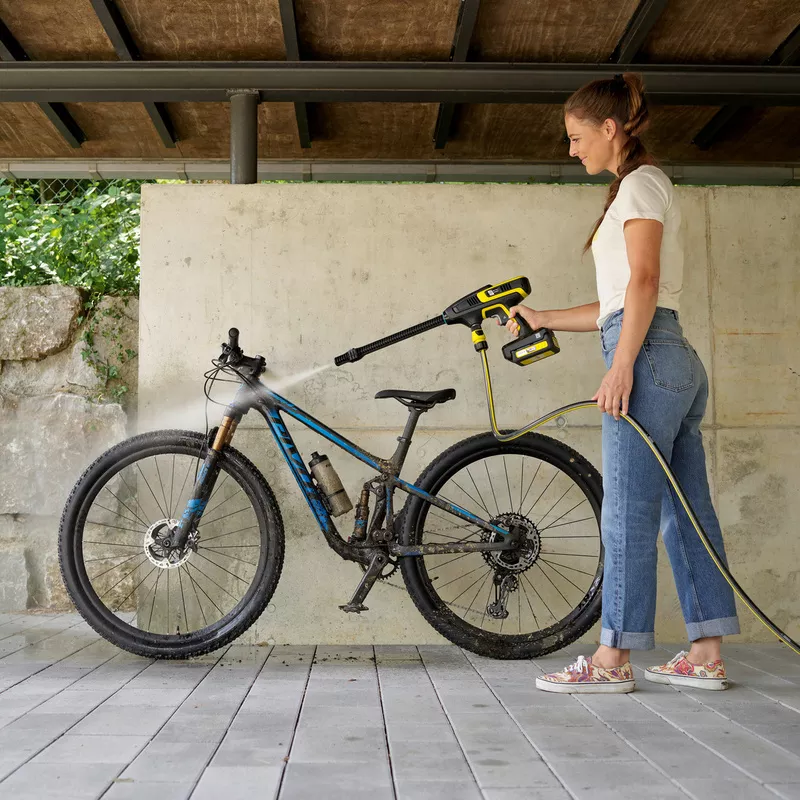 Like your car your bicycle also needs to be looked after well if you want it to last long and enjoy smoother rides every time. Also a gleaming bike reflects the personality of its owner. If you keep all your equipments in top condition you would also like to keep your bike in top condition. Regular caring and cleaning of your bicycle will also reveal any defects or wear so that timely action will help you to avoid higher repair and replacement costs later. Many people think that their bike doesn’t need any care and neglect it to the extent that, one day it needs major repairs or complete replacement much before it is expected.
Like your car your bicycle also needs to be looked after well if you want it to last long and enjoy smoother rides every time. Also a gleaming bike reflects the personality of its owner. If you keep all your equipments in top condition you would also like to keep your bike in top condition. Regular caring and cleaning of your bicycle will also reveal any defects or wear so that timely action will help you to avoid higher repair and replacement costs later. Many people think that their bike doesn’t need any care and neglect it to the extent that, one day it needs major repairs or complete replacement much before it is expected.
A major reason for fast deterioration of a bike is the neglect of its tires. Your bike needs regular pumping up of the tires. The tubes which are made from butyl rubber are not 100% airtight and loose air over a short period. The result of the loss of air pressure is the softening of tires. Depending on size the tires of road bikes can soften within a week and mountain bikes within a month. The results of riding with soft tires can be very unpleasant. When you go over a pothole or rock the rims can get bent or the tubes and tires can themselves get punctured or damaged. Underinflated tires also wear out fast. Thus it is necessary to inflate the tires regularly. Check your road bike before every ride and mountain bikes every week at least. Inflate the tires to the pressure written on the sidewall of the tire using a good pump with a built in gauge.
Many of the moving metal parts in a bicycle rub against one another and unless they are lubricated they will wear off very fast. For this reason you must keep your bike well lubricated. The rotating parts of the bicycle are usually mounted on bearings that come packed with grease. These need to be dismantled, inspected and regreased at least once a year. These parts include the pedals, wheels, headset and the bottom bracket. This is best left to the bike mechanics as they need some special tools. However the derailleurs and the brake pivot points can be lubricated quite easily. It is time to lubricate when your chain links appear shiny and bright and you hear a squeaking sound when pedaling. Use a suitable lubricant and don’t use too much of it as it will attract grit and dirt which will cause the parts to wear out faster. Allow the lube to settle and then wipe of the excess. Do this in the open space where you will not stain your carpet or expensive flooring.
Depending on how frequently you ride it you must inspect your bicycle weekly or monthly. This will prevent unexpected breakdowns and fast wear. You must inspect the brake pads to see if the grooves are worn out. If so then replace them promptly. Otherwise it will lead to loss of braking power which can be dangerous. While inspecting the braking system operate the shift and brake levers and inspect along the length of all the brake cables looking for any rusted , broken or frayed portions. If there is any damage then replace the brake cable and its housing. This way you will avoid getting stranded miles away from home without brakes.
With the help of suitable wrenches test all the bolts for looseness and tighten any that are loose. The key components to be checked are handlebar and stem bolts, the brake and shift lever bolts, seatpost and seat bolts. Tighten any loose spokes, clipless pedal screws, and bolts holding the accessories. You can increase the life of your bike by riding carefully. While riding make it a habit to scan the road ahead for potholes, rocks, broken glass, metal pieces, roots and oil spots. If you must run over something you must get up off the bicycle seat as if you are a jockey racing a horse. This technique is useful when you cannot go around obstacles like logs. If you love to jump your mountain bike then learn to land softly like a true professional. The same goes for wheelies. This way you will not only save money on replacement and repair you will also avoid injuries.
Bicycles, especially mountain bikes can collect a lot of grime and mud after some riding. Cleaning your bike regularly will not only ensure smoother rides every time but it will also make it last longer. Many people make the mistake of blasting the bike sideways with a high pressure water spray thinking that they will finish the job in minutes. This is of course a big mistake. This can force the water into the hubs, bottom bracket and pedals and get into the grease in the bearings and bushes. You must learn to wash and clean your bike carefully and systematically as described here. There is no need to wash your bike after every ride. You can clean it up with a moist rag and polish it to spruce it up after long rides. However after it has been off road for long ar after a foul weather ride you will need to clean and wash it thoroughly.
Some of the items that you will need for this purpose are a bracket or stand to hold the bike, a water source or hose, a degreaser or diesel fuel, 2 buckets, a good selection of brushes, sponges, rags, wax or polish, lubricant, steelwool for getting rid of rust, some paint for touch up. Keep the greasy brushes separate as you don’t want to get grease on bar tape and other parts. Race mechanics use diesel fuel to clean greasy portions as it contains some lubricant and the part does not become completely devoid of lubricant. Most importantly don’t place the bicycle upside down while washing as water will enter the grease in the headset. Also if you can’t find the appropriate paint for touch up the right color nail polish can be used instead.
To start with, fill both the buckets with water and add soap to one and soap and a little amount of diesel fuel in the other. The one with fuel is for cleaning the drivetrain parts. Spray the degeaser lightly on the derailleurs, cassette cogs and the chain. Don’t spray but sprinkle from the top to prevent washing away the grease. For cleaning the chain you can use a Chain Gang Cleaning System or you can clean it by scrubbing it with a stiff brush dipped in the fuel mixture while you keep cranking it. Keep cranking and scrubbing until the chain is clean. Next you should scrub the chainrings and derailleurs with the brush dipped in the fuel mixture. The space between the chainrings and other nooks and crannies can be cleaned using a rag dipped in the solution with a shoeshine action.
The next step is to wet the bike by sprinkling it with a hose from top. Use a clean brush to remove the grime and dried mud form the bicycle frame. After that clean the rest of the bike with the soap solution using the sponge and non greasy brushes. Using the sponge clean the cables, handlebar tape, underside of the seats, pedals and tubing. Clean the cassette cogs with a rag soaked in the soap solution with a shoeshine action. Both the wheels can be cleaned over the soap solution bucket. The spokes, nipples, rims, hubs, tires and cassette can be cleaned with the brushes and sponge. While at it you can look for any cracks in the rims near the nipples.
After you finish washing rinse the whole bike by holding the hose over the bike parts so that the water dribbles over them This will remove any soap and grime left. Dry out the bike with soft rags using different ones for the drivetrain and frame. Then painted and chrome parts can be waxed to prevent rusting. Finally lubricate the derailleur and brake pivots as well as the chain. To remove rubber deposits formed by the brake shoes on the rims you can use a rag soaked with acetone. Make sure to avoid the tires as it will melt the rubber. Also use gloves and avoid breathing in the vapors as much as possible.
Proper storage of the bicycle also constitutes and important part of its care. Many people think a roof overhead is adequate and leave it on a deck or porch. However moisture present in the air especially during the night will corrode the metal parts. The corrosion takes place very fast near the ocean due to salt carried by the air. Always store the bike indoors. You can hang it on the wall with the help of plastic coated hooks available for this purpose. You can also store it in stairwells or wherever you can find some dead space. These bicycle care and cleaning tips will help you to always keep your bike in top condition and enjoy smooth rides every time.
